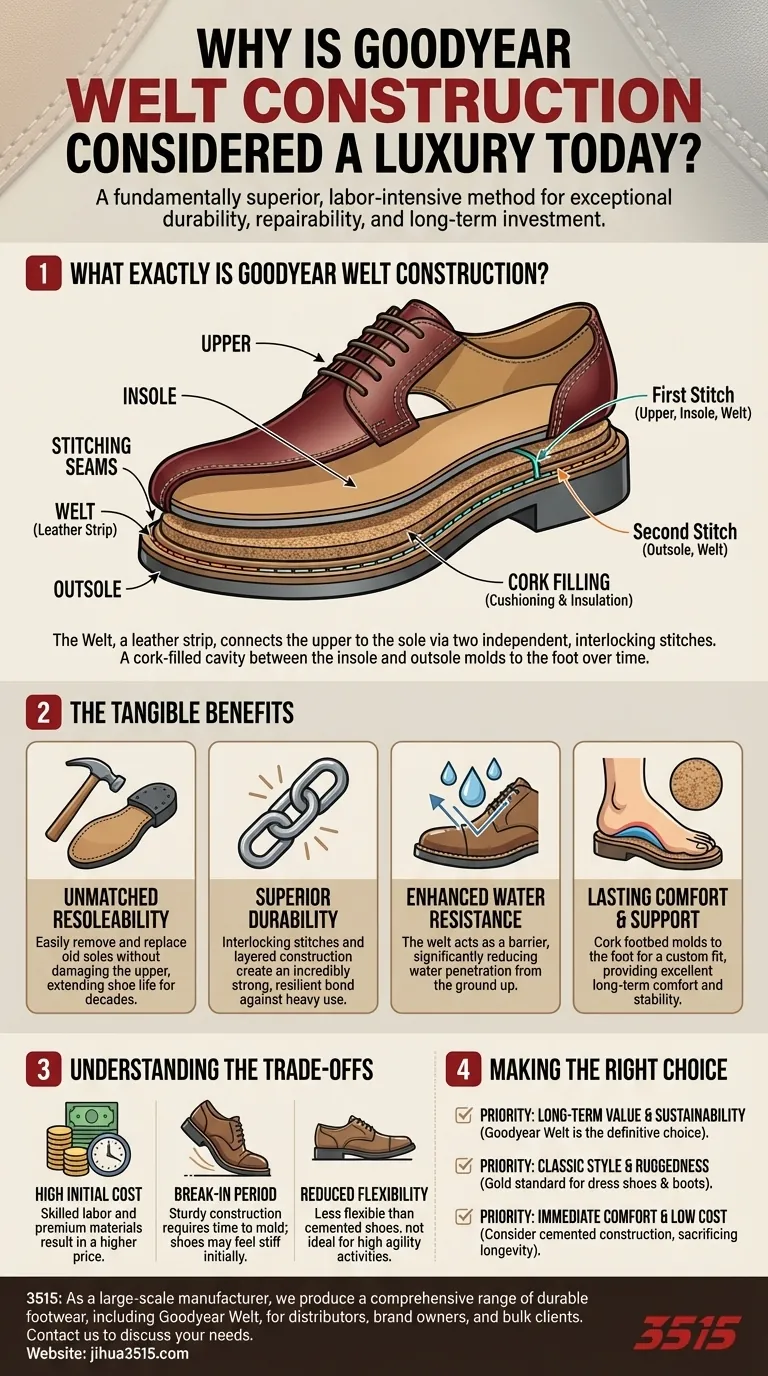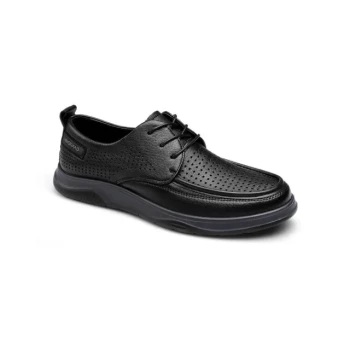At its core, Goodyear Welt construction is considered a luxury because it is a fundamentally superior method of shoemaking. It is a complex, labor-intensive process requiring skilled artisans, which accounts for less than 1% of all shoe production. This method creates footwear that is not disposable but is instead built for exceptional durability, water resistance, and the ability to be resoled multiple times, extending its life for years or even decades.
The luxury of a Goodyear Welt is not found in a brand name, but in its engineering. It represents a long-term investment in footwear that can be perpetually repaired, a stark contrast to the disposable nature of modern, mass-produced shoes.

What Exactly is Goodyear Welt Construction?
To understand its value, you must first understand its mechanics. A Goodyear Welt is not a single feature but an entire system for assembling a shoe, a method perfected over 150 years.
The Key Components: Welt, Insole, and Outsole
The star of the process is the welt, which is a strip of leather that runs along the perimeter of the outsole. This component acts as a crucial intermediary, connecting the upper part of the shoe to the sole without compromising the integrity of the upper itself.
The Stitching Process: Two Independent Seams
The genius of the Goodyear Welt lies in its use of two separate, interlocking stitches.
First, the upper is stitched to a canvas rib on the insole and to the welt. Second, the outsole is stitched directly to that same welt. This two-level stitching is the defining characteristic of the method.
The Cork-Filled Cavity
This two-stitch process creates a small cavity between the insole and the outsole. This space is filled with a layer of granulated cork. This provides excellent cushioning, insulation, and breathability. Over time, the cork filling molds to the shape of your foot, creating a personalized, comfortable footbed.
The Tangible Benefits of the Welt
The complex construction directly translates into practical, long-term advantages that justify its premium status.
Unmatched Resoleability
This is the primary benefit. Because the outsole is stitched only to the welt and not the upper, a cobbler can easily remove the old sole and stitch on a new one. This process can be repeated multiple times without damaging the shoe's upper, dramatically extending the footwear's life.
Superior Durability
The interlocking stitches and layered construction create an incredibly strong and stable bond between all parts of the shoe. This makes Goodyear-welted footwear exceptionally resilient to heavy use and daily wear and tear.
Enhanced Water Resistance
The welt acts as a small wall or buffer between the sole and the upper. This design makes it significantly more difficult for water to penetrate the shoe from the ground up compared to footwear where the sole is simply glued on.
Lasting Comfort and Support
While they require a break-in period, the cork footbed eventually provides a custom fit. The sturdy construction also offers a stable platform that provides excellent arch and foot support throughout the day.
Understanding the Trade-offs
No construction method is without its compromises. Being an informed buyer means understanding the potential downsides.
The High Initial Cost
Skilled labor and higher material costs are unavoidable. The time and expertise required to properly welt a shoe are significant, which is directly reflected in the final price tag.
The "Break-In" Period
The same sturdy materials and construction that provide long-term durability can make the shoes feel stiff and rigid at first. A "break-in" period is almost always required as the leather and cork mold to your foot.
Reduced Flexibility
Compared to a sneaker with a cemented sole, a Goodyear-welted shoe is inherently less flexible. While this provides support, it is not ideal for activities requiring a high degree of agility.
Making the Right Choice for Your Goal
Deciding if Goodyear Welt is for you depends entirely on your priorities.
- If your primary focus is long-term value and sustainability: Goodyear Welt is the definitive choice, as the ability to resole makes it a wise investment.
- If your primary focus is classic style and ruggedness: This construction is the gold standard for high-quality dress shoes, work boots, and heritage footwear.
- If your primary focus is immediate, out-of-the-box comfort and low cost: You may prefer a cemented or other construction, but you sacrifice longevity and repairability.
Ultimately, choosing a Goodyear-welted shoe is an investment in craftsmanship designed to last a lifetime.
Summary Table:
| Feature | Benefit |
|---|---|
| Resoleability | Can be resoled multiple times, extending shoe life for decades |
| Durability | Interlocking stitches create a strong, stable bond resistant to wear |
| Water Resistance | Welt acts as a buffer, reducing water penetration from the ground up |
| Comfort | Cork footbed molds to your foot over time for a personalized fit |
As a large-scale manufacturer, 3515 produces a comprehensive range of durable footwear for distributors, brand owners, and bulk clients. Our production capabilities include Goodyear Welt construction and other premium methods, ensuring your customers receive high-quality, long-lasting shoes. Contact us today to discuss how we can meet your footwear manufacturing needs with craftsmanship built to last.
Visual Guide

Related Products
- Durable Rubber-Soled Utility Shoes for Wholesale & Custom Brand Manufacturing
- Wholesale Durable & Breathable Training Shoes for Custom Brands
- Wholesale Training Shoes with Dial Lacing System Custom OEM Manufacturing
- Premium KPU Athletic Safety Shoes for Wholesale
- Factory Direct Wholesale Leather Comfort Shoes with Dial Closure
People Also Ask
- What are the disadvantages of leather shoe soles? Key Limitations in Traction & Durability
- What makes rubber sole shoes an economical and practical choice? Unmatched Durability & All-Weather Value
- What are the benefits of rubber work shoes? Unbeatable Protection for Wet & Demanding Jobs
- What is vulcanized rubber and why is it used in products? The Key to Durable, Flexible Footwear
- What makes natural rubber provide excellent traction and grip? Unlocking Superior Performance with Molecular Science



















